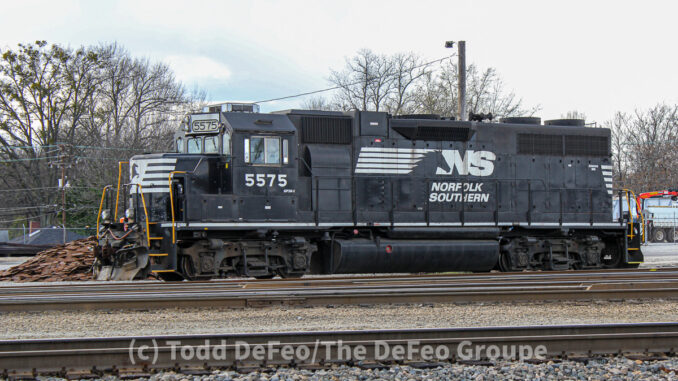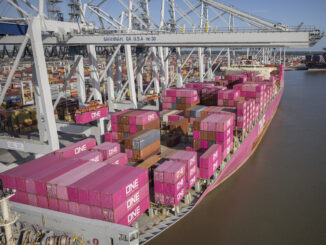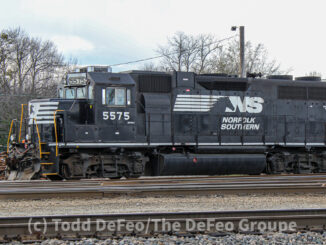
by David Wren, SC Daily Gazette
July 17, 2025
A late-in-the-game demand by Norfolk Southern railroad is hiking the price of an already over-budget rail yard the South Carolina State Ports Authority is building to support cargo shipments through the Port of Charleston.
Norfolk Southern has told the authority it won’t use the rail yard — known as the Navy Base Intermodal Facility — unless the authority spends $27 million to install a new track at the Ashley Phosphate Road crossing that trains must navigate while making their way to the North Charleston facility.
Barbara Melvin, the authority’s president and CEO, told state legislators this week that Norfolk Southern made the demand within the past year. The rail yard project has been in the works for more than a decade.
Melvin told a subcommittee of the state’s Joint Bond Review Committee that Norfolk Southern originally was going to pay for the Ashley Phosphate project as part of its own capital budget.
“It was improvements they were making to their own rail network outside of this (rail) project,” Melvin said, adding the railroad recently shifted that cost to the authority.
“So, what we’re saying is that Norfolk Southern is choosing to take the opportunity to lay (millions) from their capital budget requirements for their company on the taxpayers of South Carolina,” said Sen. Sean Bennett, a Dorchester County Republican.
“I think at this point they’re choosing to lay it on the (authority’s) board,” Melvin replied, adding that no further state money is available for the project.
Melvin said the authority has no choice but to pay it because the rail project won’t work without Norfolk Southern’s participation.
“That’s probably pretty good negotiations on their part,” Bennett said.
“There are times I wish I had that much power,” Melvin responded.
Norfolk Southern said in a written statement that its “role has been and continues to be to inform the requirements for the port’s investment in this project.”
The railroad did not address questions about where it had shifted the costs from its own budget to the authority’s.
“We remain committed to the success of the Navy Base Intermodal Facility and to collaborating to get this facility online as quickly as possible to benefit our mutual customers and South Carolina’s strong logistics network,” the statement reads.
The rail yard project has already blown its deadline for opening this month.
The debut is now scheduled for January 2026, although only the facility’s northern entrance will be available at that time. A southern entrance, which is still in the design stage, won’t be ready until March 2027.
The work that Norfolk Southern is demanding is called “siding” — a section of track adjacent to the main line where trains can stop while waiting for a clear route to their destination; in this case, the rail yard located on Navy Base property next to the port’s Leatherman Terminal.
Norfolk Southern needs the siding because CSX Corp. — the other railroad that has agreed to use the rail yard — has the right-of-way along the Ashley Phosphate Road crossing.
At $27 million, the four miles of track needed for the siding comes to about $6.75 million per mile.
“That’s a lot of money per mile,” Bennett said.
It’s money the authority will have to come up with because it has vowed not to seek more state funding for the rail yard.
The Legislature approved spending $550 million in public funds in 2022 for the rail yard and a separate barge project that would move cargo containers by water between port terminals. The rail yard, however, is eating up almost all of that.
The 118-acre rail yard’s current budget is $544.7 million — up from $349 million in 2022. The southern access is estimated to cost another $145 million.
In addition to paying for the siding, Norfolk Southern wants the authority to help it find alternate uses for its Seven Mile Yard in North Charleston, where cargo containers are currently moved to and from trains. Once the Navy Base Intermodal Facility opens, the Seven Mile Yard will no longer be needed for that purpose.
“The conversations that we have had with Norfolk Southern are about repurposing the existing Seven Mile that would allow for … some type of activity that is related to the port,” Melvin told the subcommittee. “There is a future opportunity for us to work together to create value on the land that they would no longer be utilizing, that is used today for their intermodal yard.”
About 25% of the port’s cargo containers currently move by trains. That’s roughly 600,000 containers measured in 20-foot increments each year, with the rest hauled by trucks from the port’s terminals.
The authority hopes to boost train shipments while taking some trucks off local roads. The rail yard will eventually have capacity for moving 1 million containers annually to and from trains.
The rail yard will eventually have direct access to the adjacent Leatherman Terminal, giving the Port of Charleston the near-dock rail it needs to stay competitive with other East Coast ports.
SC Daily Gazette is part of States Newsroom, a nonprofit news network supported by grants and a coalition of donors as a 501c(3) public charity. SC Daily Gazette maintains editorial independence. Contact Editor Seanna Adcox for questions: info@scdailygazette.com.





